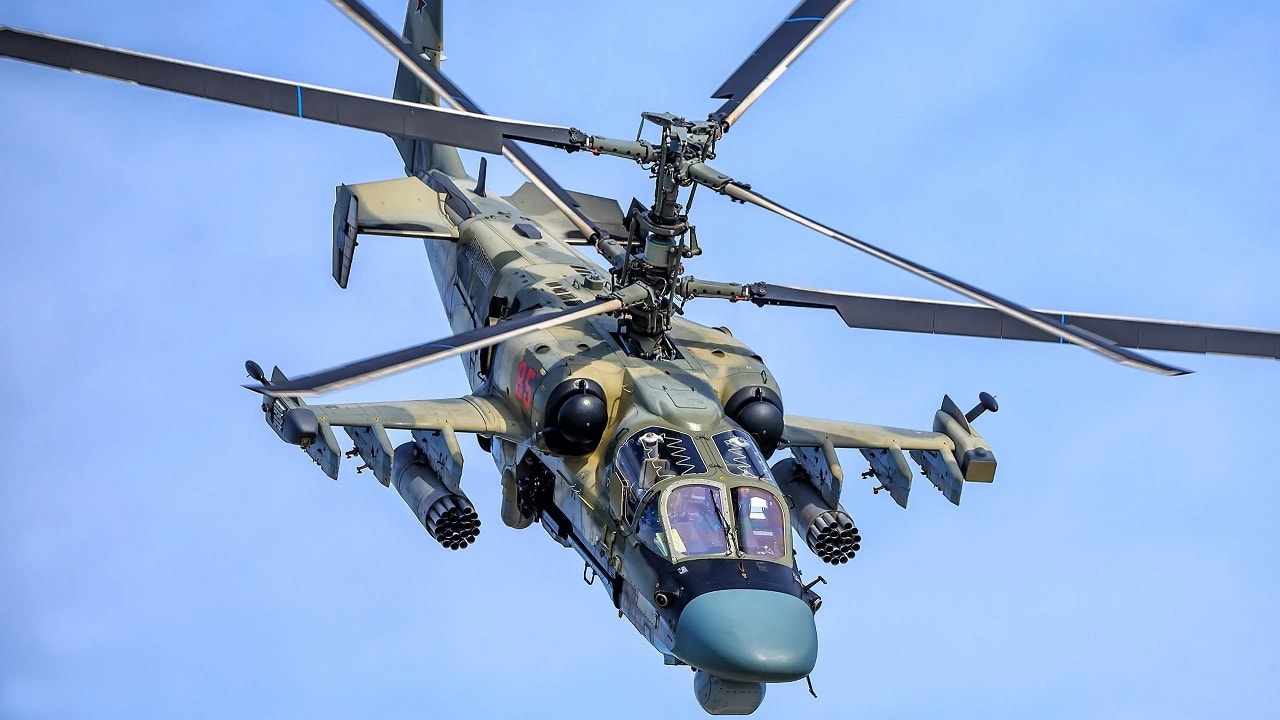Russia’s Defense Ministry recently published the footage of the Ka-52 and Mi-24 combat helicopters operating as part of Russia’s ongoing military operation in Ukraine.
The video was shared on November 16. The choppers belonged to the Central Military District, the largest of Russia’s five military districts in terms of geographic size at 7,060,000 square kilometers – 40% of Russian territory.
The Russian Defense Ministry said in a statement accompanying the video that the pilots of Ka-52 and Mi-24 helicopters operate in mixed pairs to increase the strike potential.
Two helicopters have been destroying Ukrainian tanks and infantry fighting vehicles (IFVs) using guided and unguided projectiles.
“The crew of the Ka-52 and Mi-24 carry out covert approaches to targets at extremely low altitudes; helicopter pilots launch aircraft missiles from a pitch-up to increase the range of destruction,” said the Russian Ministry of Defense.
Since April, Russian combat helicopters are known to have primarily relied on unguided rockets for attacks on known Ukrainian positions from behind the Russian frontlines.
Usually, the Russian helicopters would approach a target area at altitudes less than 60 meters, and then pitch up between 15 and 30 degrees and fire S-8 and S-13 unguided rockets in high ballistic arcs, which allows the helicopter crew to remain behind the Russian frontlines, where the threat from Man-Portable Air Defense Systems (MANPADS) is somewhat less.
Russian media released more footage of Ka-52 activity over eastern Ukraine, note the use of unguided S-8 rockets fired in a ballistic arc pic.twitter.com/ISQisZZ9Dq
— OSINTtechnical (@Osinttechnical) June 29, 2022
However, the strike accuracy using these tactics is usually poor, sufficient only to force the Ukrainian forces in the open to take cover or to fix dug-in units in place until the impacts subside, according to a recent study on the Russian Air War in Ukraine, conducted by London-based Royal United Services Institute (RUSI).
In Russian-held regions of Ukraine, particularly in Donbas, the Ka-52 and Mi-24s regularly conduct such attacks during nighttime to keep Ukrainian troops awake.

Ka-52s Forced To Operate From Russia
The Ka-52 ‘Alligator’ is one of Russia’s predominantly used ground-attack platforms in its military campaign in Ukraine alongside the Su-34 bomber fleet. The Alligator is considered one of the best attack helicopters in the world.
The Ka-52 has better optics, night-vision devices, and precision missiles than other Russian gunship helos like the Mi-24/35 Hind and Mi-28 Havok.

Also, the Russian Aerospace Forces (VKS) assigned the Ka-52 to support Russian special operations forces, particularly at night. A much larger proportion of Ka-52 aircrew were likely trained in low-level night operations.
The superior training of the Ka-52 aircrews made them indispensable to Russian military planners in the first few weeks of the invasion of Ukraine to support Russian brigades marching toward Kyiv to destroy the Ukrainian government and force the Ukrainian armed forces to surrender.
However, the deep penetration strikes resulted in heavy losses for Russia’s Ka-52 fleet.
The Ukrainians took down several of these Ka-52s using short-range, infrared-guided MANPADS. While the defensive aids suites of Russian combat aviation platforms comprising missile-approach warning sensors and countermeasures-dispensing systems have been reasonably effective throughout the ongoing war, there were just too many MANPADS to evade!
#Ukraine: New footage shows the moment one of the Russian Ka-52 attack helicopters leaving – it drops heat flares trying to avoid MANPADS fire and at the same time in the background the second Ka-52 crashes on the ground.https://t.co/0UTuf3hsYg pic.twitter.com/B9xFcuARB6
— ?? Ukraine Weapons Tracker (@UAWeapons) April 22, 2022
The sheer number of MANPADS fired at Ka-52s during their deep penetrating sorties ensured that many of them were shot down.
Also, there were several instances during early March and even later when the focus of the war shifted to Donbas, where Russian helicopters failed to release flares when engaged by MANPADS, according to interviews conducted by the experts at RUSI.
Furthermore, the Ukrainian forces reportedly used the British Starstreak and the American Javelin anti-tank missile (used in direct attack mode), which were especially effective against all Russian helicopters as they are immune to being decoyed by flares or chaff countermeasures.
After suffering heavy losses and the humiliating retreat from Kyiv in April, the Russian rotary crew appeared hesitant to operate behind Ukrainian frontlines. This resulted in a substantial reduction in the number of deep-penetrating strikes and hunter-killer sorties across all the gunship fleets after April, the report states.
Helicopter Crew Prefers Unguided Rockets?
Besides using unguided rockets, Russian Ka-52s use the 9K121 Vikhr laser-guided anti-tank missiles to carry out precision strikes while staying behind Russian frontlines. However, there is a downside to this.
Russian Ka-52 operations in the east of Ukraine. Equipped with 2 B8V20A rocket pods and 4 Vikhir ATGMs, VKS forces continue to rely on unguided rockets fired from a standoff distance. pic.twitter.com/dK8BPYybC6
— OSINTtechnical (@Osinttechnical) June 23, 2022
The Vikhr ATGM relies on a laser beam-riding guidance system with a seeker mounted at the rear of the missile facing backward rather than in the missile’s nose, which is usually the case with laser seekers.
So, the Vikhr looks back at the helicopter to follow the laser guidance beam rather than a laser spot reflected off the target, which makes it next to impossible to jam in flight but also forces the Ka-52 to maintain a steady position until the missile hits the target.
#Ukraine: A Russian Ka-52 attack helicoper successfully hitting a BDRM-2 armoured car of the Ukrainian forces with a 9K121 Vikhr ATGM. pic.twitter.com/UUzIvljwdB
— ?? Ukraine Weapons Tracker (@UAWeapons) July 10, 2022
This makes them an easy target for Ukrainian MANPADS shooters close by; therefore, even after abandoning deep-penetration operations, the Ka-52s risk getting shot down.
Whereas, in the case of unguided rockets, the Russian helicopters can immediately turn away after firing all their rockets in a salvo without even crossing their frontlines, which should help explain why the Russian helicopter crew prefers to use unguided missiles.
Russian Ka-52 Fleet Suffers Most Losses
Overall, the Russian military has lost at least 27 Ka-52 helicopters, of which six were destroyed on the ground, and one was destroyed in a non-combat related incident, according to the latest figures compiled by the military tracking blog Oryx based on visual confirmations.
This is more than the combined losses of Mi-24/35 Hind and Mi-28 Havok fleets which stand at 10 and 9, respectively.

The Ka-52 fleet has seen more intensive use than the other gunship types.
Also, the Ka-52’s armor protection is deficient compared to other Russian attack helicopters, particularly the engine compartments, which have no armor plating – leaving them potentially vulnerable to damage from even small arms fire.
Before invading Ukraine, the Russian military was known to have around 100 Ka-52s, but after losing 27 of them nine months later, the Russian Ka-52 fleet has lost more than a quarter of its strength.
It is also important to remember that the actual number of losses may be higher.
- Contact the author at tanmaykadam700(at)gmail.com
- Follow EurAsian Times on Google News




